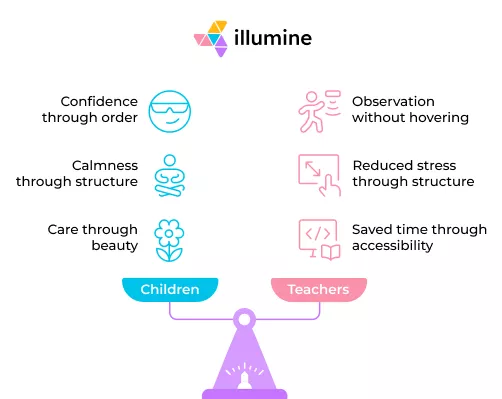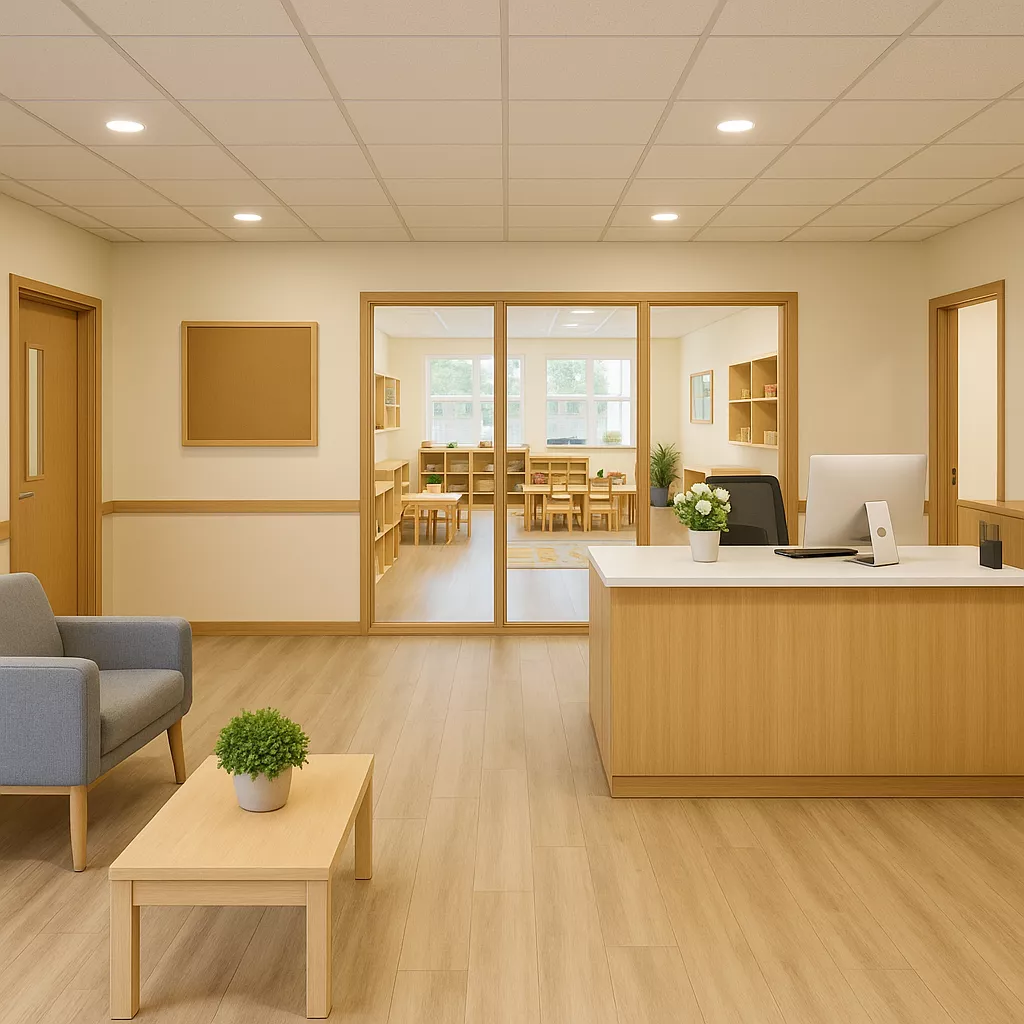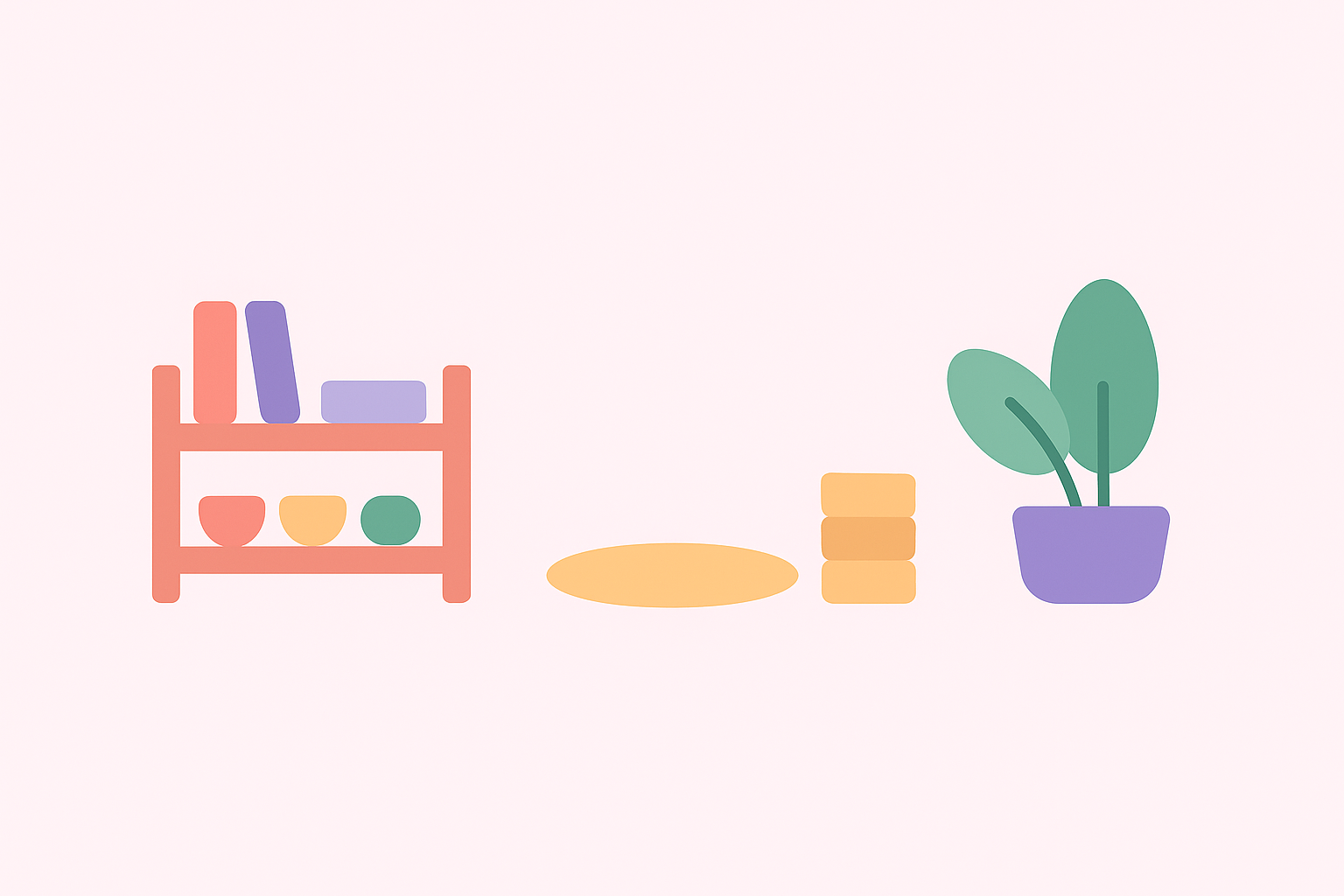After visiting hundreds of preschools, I’ve noticed one truth standing out: the best ones don’t just look beautiful; they feel right.
When you step into a well-designed classroom, there’s a calm sense of purpose. Light feels soft, children move with quiet confidence, and every corner invites discovery. Learning happens naturally because the environment itself supports it.
Designing a preschool is more than choosing colors or furniture. Every shelf, window, and walkway communicates belonging, respect, and curiosity. The space becomes a silent partner in teaching, helping children concentrate, cooperate, and feel capable.
Whether you’re creating a Montessori classroom, a play-based center, or exploring new daycare room setup ideas, the goal is simple: build spaces that nurture independence, joy, and peace.
Why Setup Matters: The Power of Space
I have seen how much the physical setup of a classroom can change the rhythm of a day. It becomes a space that allows children to move, explore, and settle naturally.
A good preschool setup is not about how much you can fit into a room, it is about what the space allows children to do.
When planning your classroom layout for preschool, ask yourself:
- Does this space invite curiosity and purposeful movement?
- Can children find materials, use them, and return them on their own?
- Are transitions from play to snack and work to rest smooth and natural?
- Can teachers see and reach every child easily?
If you can answer “yes” to most of these, you already have the beginnings of a strong, functional classroom. A space designed with care becomes your quietest and most consistent teacher.
The Real Benefits of Thoughtful Design

For Children: Confidence, Calmness, and Curiosity
When the environment supports a child’s natural instincts to move, touch, and explore, learning happens effortlessly.
- Visible order builds confidence.
Clear shelves and labeled areas let children find what they need, use it, and return it independently. This freedom tells them, “You are capable.” - Defined zones encourage calm.
Separate spaces for art, reading, and building help children make choices without feeling overwhelmed. Structure replaces chaos with quiet purpose. - Beauty invites care.
Soft light, natural materials, and balance in design help children focus. They begin to care for their surroundings because the space itself feels cared for.
For Teachers: Flow and Focus
When classrooms are arranged with intention, teachers spend less time managing and more time connecting.
- Good sightlines mean better supervision.
Teachers can observe without hovering, allowing children the dignity of independence. - Smooth pathways reduce stress.
Clear walkways and logical placement of materials prevent bottlenecks and noise, helping the day flow naturally. - Accessible storage saves time.
When supplies are within reach, teachers can stay engaged instead of interrupting activities to fetch materials.
Design Principles for an Effective Classroom
1. Form Follows Function
Children learn best in spaces that are calm, organized, and purposeful. When each part of the classroom serves a clear purpose, children move naturally and focus better.
The following principles form the foundation of any good preschool design.
Orderly
Order in the room creates order in the mind.
Everything should have its place, and the layout should make sense. When children know where things belong, they build habits of care and responsibility.
Example: A teacher added picture labels to baskets and shelves. Within a week, cleanup time dropped because children knew exactly where to put things back.
Accessible
Classroom materials and fixtures should match the child’s scale. Low shelves, small furniture, and reachable sinks let children act without help. This builds independence and reduces daily interruptions.
Example: A school lowered coat hooks so even toddlers could hang their jackets. The change gave children a quiet sense of pride and control.
Beautiful
Children focus better in rooms that feel calm and natural. Use soft light, wood tones, and neutral colors. Avoid clutter, bright plastics, or harsh light. A beautiful classroom shows children that their work and surroundings matter.
Flexible
Design your space so it can grow with the children. Light furniture, movable tables, and open shelves make it easy to adapt for new activities or groups. Flexibility keeps the environment fresh and useful without adding clutter.
A classroom that follows these four principles feels peaceful, clear, and alive. It helps children explore freely, stay focused, and take ownership of their learning.
2. Zones That Work
%20(3).png)
Every great preschool classroom layout balances freedom with order. The room feels peaceful, complete, and never crowded. Every shelf, table, and material serves a clear purpose.
When you plan a classroom layout for your preschool, think of it as a small ecosystem where each zone supports a specific kind of growth. Children should know instinctively where to go for calm, for creation, or for discovery.
Practical Life Area
Place this near a sink or water source with low shelves for real-life activities such as pouring, polishing, washing, and preparing food.
Why it matters: Everyday tasks teach coordination, independence, and care for the environment. Children feel capable when they can handle real tools in real ways.
Sensorial Area
Position this space where natural light is abundant. Include materials with textures, weights, colors, and sounds to refine the children's senses.
Why it matters: Sensorial exploration helps children notice fine differences and builds a foundation for logic and classification. It is the bridge between curiosity and understanding.
Language and Literacy Area
Create a cozy, inviting corner for conversation, storytelling, and reading. Include movable alphabet sets, vocabulary cards, and books displayed face-out.
Why it matters: A warm, comfortable space encourages longer engagement with reading and spoken language. Children associate learning with comfort and connection.
Math Area
Use stable shelving for counting rods, beads, and other precise materials. Keep the area uncluttered and consistent.
Why it matters: Math requires focus. A clear, predictable space helps children return materials to the same spot, promoting order and self-correction.
Cultural Studies Area
Include maps, plants, small globes, artifacts, or nature displays. Rotate items seasonally to reflect the world beyond the classroom.
Why it matters: These materials connect children to geography, science, and art. They invite storytelling and nurture a sense of wonder about the larger world.
Peace or Reflection Corner
Provide a soft place for rest and emotional reset, like a small rug, cushion, or tented nook.
Why it matters: Self-regulation begins when children have access to calm. This area reminds them that peace is always within reach.
Practical Considerations
Furniture: Choose light wood or neutral tones. Pieces should be sturdy yet light enough for children to move safely. This fosters ownership and flexibility.
Lighting: Use natural daylight whenever possible. Warm, dimmable lights work better than fluorescent bulbs, which can overstimulate young eyes.
Acoustics: Add rugs, curtains, or soft panels to absorb sound. A quieter room encourages children to speak gently and listen carefully.
Flow: Arrange furniture so movement is smooth and uninterrupted. Avoid bottlenecks and maintain clear sightlines for teachers. Children should move freely without colliding or crossing paths unnecessarily.
Storage: Keep bulk supplies hidden to preserve calm. Visible clutter distracts both children and adults from meaningful work.
3. Sizing Your Space
A well-planned preschool classroom layout begins with knowing how much space you truly need.
Most states recommend around 35 square feet of indoor space per child and about 75 square feet of outdoor play area. But numbers alone do not tell the whole story.
When you add 25–40% more for hallways, bathrooms, and staff areas, you are creating space for movement, privacy, and calm transitions.
Children need breathing room, and teachers need places to rest and reflect. A slightly larger layout may seem like a luxury, but it prevents crowding, noise, and stress during busy times of the day.
For example, a preschool of 100 students should plan for 6,000–7,500 square feet of indoor space, plus a generous outdoor environment.
When space feels open, yet defined, children move confidently and with purpose. It gives the whole classroom rhythm and ease.
4. Designing for Mixed Ages
In Montessori and other holistic preschool environments, children of different ages learn together. Mixed-age classrooms build empathy and leadership, but they also need thoughtful design.
Each developmental level requires different tools for independence.
- Toddlers (18 months–3 years) need low shelves, open floor space, and sturdy furniture that invites movement.
- Older preschoolers (3–9 years) need clearly defined work areas and tables that allow for concentration and collaboration.
Consider connecting classrooms with shared gardens or hallways. These become gentle transition zones. Children can observe, visit, or join older peers while keeping their own peaceful work area.
5. Outdoor Environments

An outdoor area is not a break from learning, it is part of it. Children should experience nature every day, not just during a short recess.
A strong daycare room setup idea extends into the outdoors. Think of it as your classroom without walls.
Include:
- Gardens for planting, watering, and harvesting. These teach responsibility and patience.
- Sand, water, and loose-parts play for experimentation and sensory learning.
- Shaded gathering spots for group time or quiet reading.
- Paths for walking, running, or tricycles to support motor skills.
- Quiet nooks for reflection and rest.
Whenever possible, use natural materials like wood, stone, grass, and mulch. Plastic playsets can feel noisy and artificial, while natural textures nurture peace and curiosity.
6. Safety and Accessibility: Ensuring Peace of Mind
Safety and accessibility are not just licensing requirements. They communicate care and trust.
Integrate safety features early in your preschool setup plan, not as last-minute additions.
Key elements include:
- Child-height sinks with tempered water, encouraging independence while preventing burns.
- Non-slip flooring and rounded corners to reduce accidents.
- Clearly marked exits and illuminated signage for quick, calm evacuation.
- ADA-compliant ramps and bathrooms so every child can move freely.
- Secure but welcoming entry systems, such as buzz-in doors with visual access.
- Thoughtful fencing that ensures supervision without creating a harsh boundary.
When safety feels invisible, children feel free. The goal is protection without pressure so that curiosity can flourish.
7. Administrative and Common Areas

The heart of a school beats in its classrooms, but its common spaces keep it running smoothly. Even the most child-centered environment needs places for teachers, families, and operations.
Plan for:
- Reception area: This is the first impression of your school. Keep it calm, tidy, and warm.
- Conference or observation room: Interior windows let parents or directors observe without interrupting learning.
- Staff workspace: Teachers need a quiet place for documentation and collaboration.
- Break area or small kitchen: Comfort builds morale and reduces burnout.
Allocate around 10–15% of total area for administrative and staff needs. These spaces sustain the people who sustain your children.
8. Color Palette and Materials
Color and texture shape how a room feels. In Montessori-inspired preschool design ideas, beauty is quiet and purposeful.
- Walls: Choose soft neutrals like warm white, sage, sand, or pale gray.
- Furniture: Use natural wood whenever possible. It ages gracefully and brings warmth.
- Artwork: Display realistic, child-level pieces that reflect diversity and nature.
- Textiles: Keep them simple, washable, and calm in tone.
Example: A teacher replaced bright posters with child-made art and neutral curtains. Within days, the room felt calmer and children stayed engaged longer.
9. Budgeting for Design

Design choices influence not just aesthetics, but function and long-term success. Thoughtful design can increase enrollment appeal and daily satisfaction.
Typical costs:
- Architectural and interior design: 8–12% of total construction cost.
- Montessori classroom furnishings: $25,000–$40,000 per room.
- Outdoor environments: $50,000–$150,000 depending on scope.
Saving wisely means protecting what matters most.
- Start with essentials; add extra rooms (like music or library) in later years.
- Refurbish solid existing furniture rather than buying new.
- Partner with families for garden or landscaping contributions.
A Place That Tells Your Story
Every part of a school tells a story. From the front door to the way sunlight falls on a child’s work table, your preschool classroom layout quietly reveals who you are and what you believe about children.
When a family walks in, they can feel it right away. The room itself says, “You belong here. You are capable.”
Children pick up on that energy, too. They absorb the atmosphere as much as the lessons. When a classroom feels calm and respectful, children rise to meet it.
I once visited a school where the director smiled and said, “When new families tour, I don’t need to explain much. They feel it the moment they step inside.” And she was right. The space spoke for itself.
Designing a preschool isn’t about keeping up with trends or checking boxes. It’s about creating an environment that supports focus, kindness, and quiet joy.
When that happens, your school becomes more than a building. It becomes a living invitation to learn, belong, and grow.









.webp)